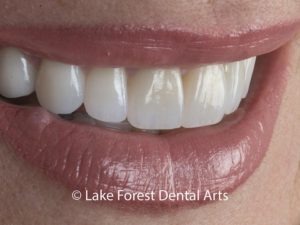
Problem: “I’ve been told that bonding is just as good as getting veneers, but it costs less. I’m not sure which one is right for me.” Treatment planning for smile makeovers usually includes a discussion of using bonding vs veneers. The answers vary from patient to patient.
Solution: “You need to learn what bonding and veneers can do for your smile. When you understand these two treatments, you’ll see how they’re similar but also very different. The solution to your problem is education!”
In this article, you’ll learn:
- What bonding is
- What porcelain veneers are
- How these two treatments differ
- The pros and cons of veneers vs bonding
- How to find a dentist who can help you
What is teeth bonding?
Do you have any white fillings in your existing teeth? The tooth colored resin can be used for both filling cavities and for composite bonding. It’s called tooth colored composite resin, and it contains no metal at all.
Bonding is a procedure in which a tooth colored resin is molded onto teeth. The dentist adds color to the resin so that it matches the natural teeth. Resin has components that give it good strength and similar reflective quality to tooth enamel.
After the plastic composite bonding material is applied to a tooth, a special light hardens the material. In its final form, plastic teeth are strong enough to endure biting and chewing. It can last five to 10 years (and often longer) if cared for properly.
When comparing bonding vs veneers, the former is often thought of as the easiest and least expensive cosmetic option. Remember to brush and floss to maintain your bonding.
Bonded fillings can:
- Make teeth wider (to close spacing)
- Make teeth larger
- Cover the front surface of a tooth
- Hide the dental imperfections of discolored teeth
- Provide a coating over teeth, for protection
- Add structure to oddly shaped or crooked teeth (to create a straight appearance)
What are veneers?

Well done porcelain veneers offer a beautiful smile!
Veneers are small, handmade, or shaped composite resin or ceramic shells that the dentist secures to the surface of front teeth. They are resistant to stains from red wine and coffee tea. Composite veneers are inexpensive and can be completed in one appointment.
The porcelain material is strong and natural looking. When comparing bonding vs veneers, the latter is stronger, more life-like, and lasts much longer. With good oral health and proper care, veneers can last 20+ years. Most patients have veneers placed on the eight to 10 teeth that show when they smile.
The cosmetic dental procedure can achieve the same goals that dental bonding can, such as:
- Close spacing between teeth
- Make teeth look longer or wider
- Correct the shape of teeth
- Reshape a chipped tooth
- Provide instant, lasting whitening to a discolored tooth
How composite bonding used in a total smile makeover?
A complete smile makeover involves two or more cosmetic procedures, as well as other treatments as needed. Smile makeovers transform the appearance of a smile by reshaping or replacing teeth.
A cosmetic dentist may employ any of these procedures with composite bonding to create a smile makeover plan:
- teeth whitening
- pretty white crowns
- porcelain veneers
- white fillings
- gum contouring
- braces or Invisalign (orthodontics)
- bridges
- dental implants
Advantages of bonding vs veneers?
Resin bonding takes just one visit and veneers take two or more: Bonding is a direct restoration, meaning it is created and placed in the dentist’s office. In contrast, porcelain veneers are indirect restorations. They are fabricated in a dental lab, according to the dentist’s design.
Bonded teeth last five to seven years and porcelain can last up to 20: Composite resin is not as durable as dental porcelain. Generally, resins can last five to ten years, sometimes longer. In comparison, porcelain may last up to 20 years or more.
Composite is often used on children, but not porcelain veneers: Children commonly chip teeth while playing or competing in sports. White filling material is used to fix the broken tooth. This resin can be easily replaced as the child’s teeth grow. Veneers, however, are not the preferred restoration for children.
Disadvantages of bonding
While composite veneers can give you a perfect smile, it is not permanent. The enamel on that tooth may change color over time, but the artificial plastic will not change. The plastic fillings may appear “off.” At this point, the plastic resin should be replaced to match better. Also, the seam between the resin and the tooth enamel may stain. Again, this indicates that it’s time to replace the composite.
Dental insurance pays a portion of some procedures. The amounts vary based on the premium paid.
Learn how to choose between bonding vs veneers to improve your smile
Now that you’ve learned about tooth bonding and porcelain veneers, you’ll have the information necessary to understand what the cosmetic dentist recommends. The cost of cosmetic dentistry procedures like the ones listed is worth the investment.
